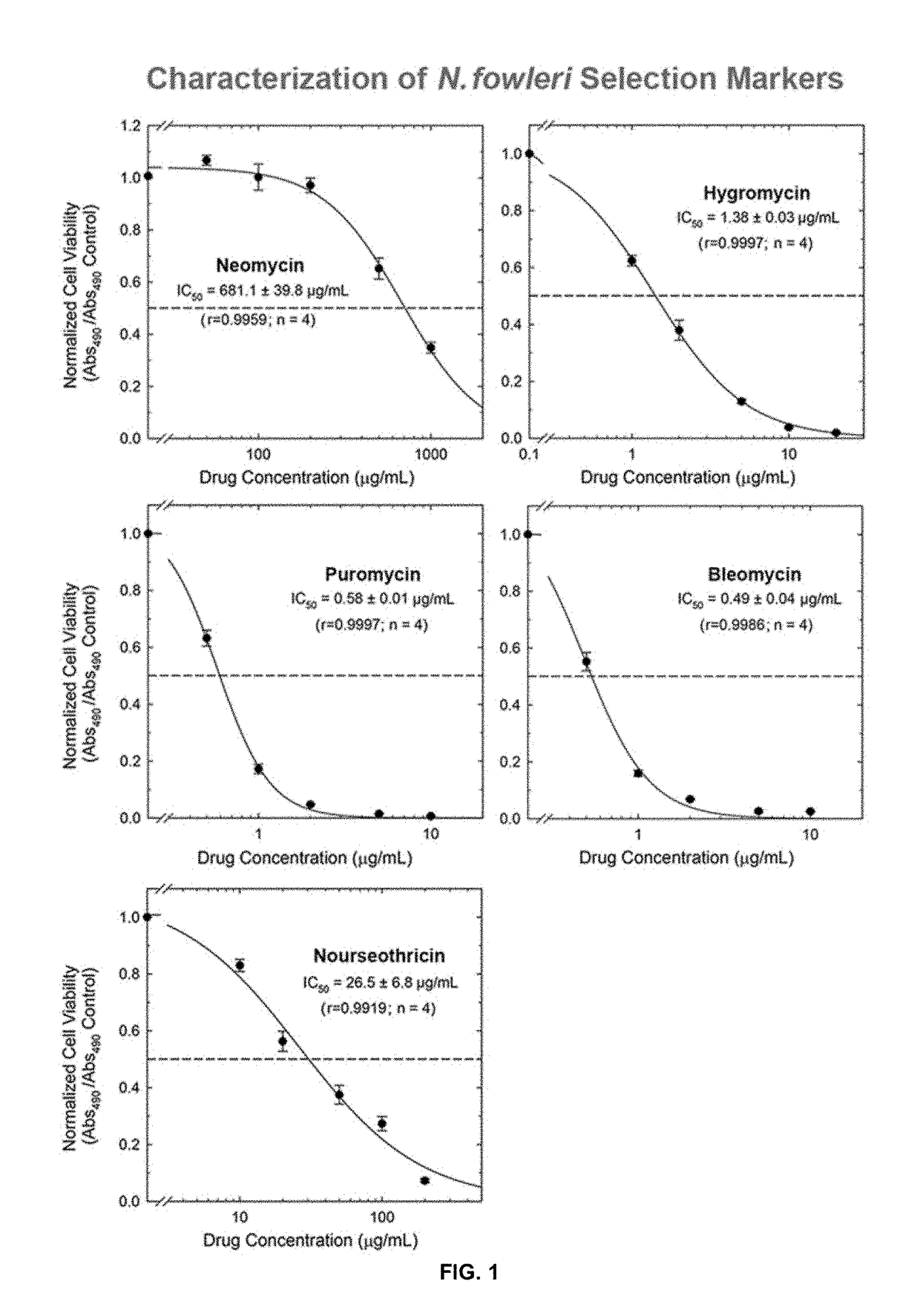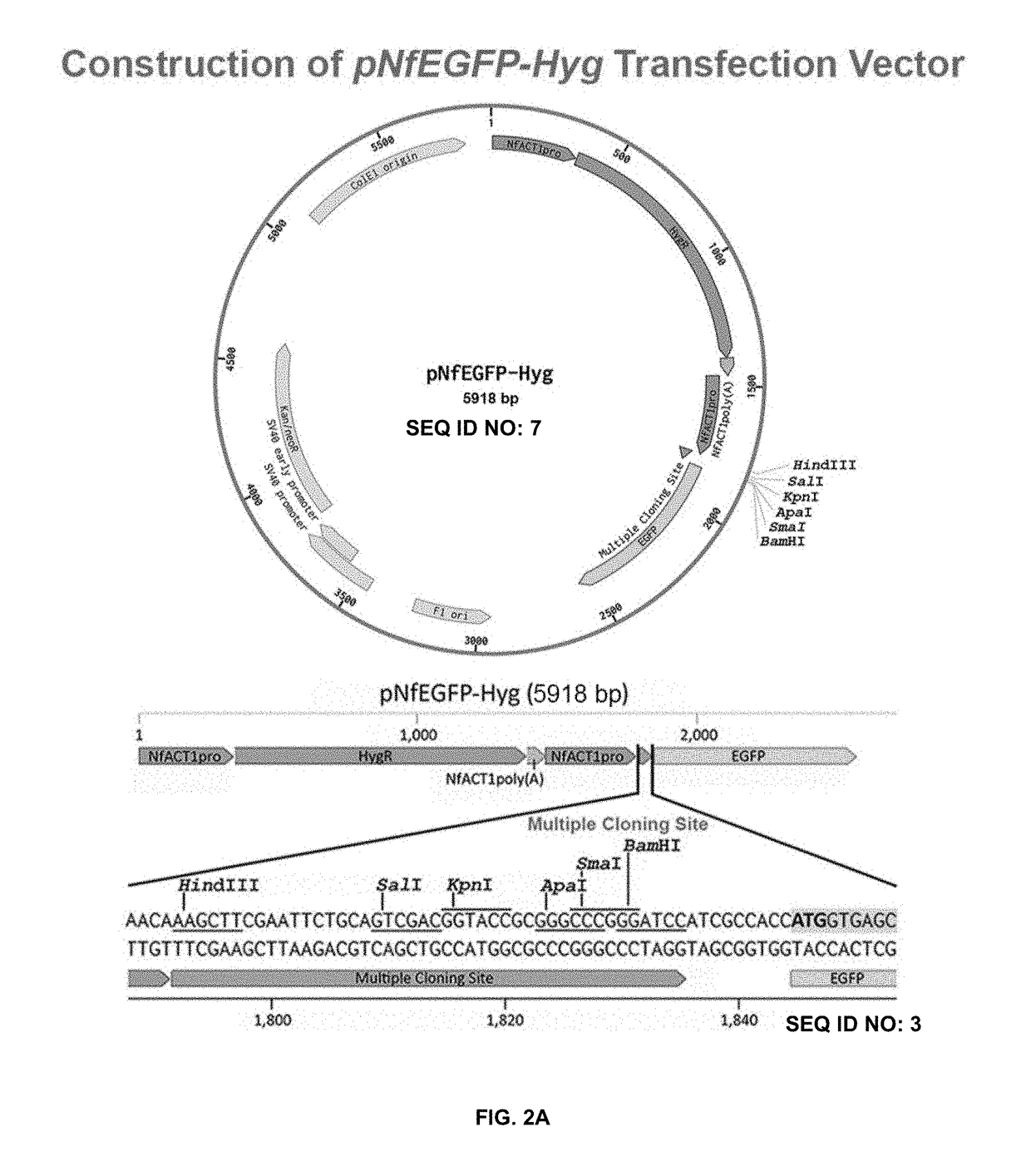Transfection vector for pathogenic amoebae and uses thereof
a technology of amoebae and transfection vectors, applied in the field of vectors, can solve the problems of amoebic keratitis, fatal granulomatous amoebic encephalitis (gae), and a particular threat to people wearing contact lenses
- Summary
- Abstract
- Description
- Claims
- Application Information
AI Technical Summary
Benefits of technology
Problems solved by technology
Method used
Image
Examples
example 1
Screening of Selection Markers
[0090]Preliminary experiments revealed that N. fowleri has natural resistance to neomycin. Five different selection markers were screened for their suitability to use in an N. fowleri transfection system. MTS viability assays in N. fowleri revealed IC50 values of neomycin for 681 pg / m L, 1.4 pg / mL for hygromycin, 0.6 pg / mL for puromycin, 0.5 pg / mL for bleomycin, and 27 pg / mL for nourseothricin (TABLE 1 and FIG. 1). The results indicated that hygromycin, puromycin, bleomycin, and nourseothricin would be suitable independent selection markers for N. fowleri. Hygromycin was used in subsequent studies as the selectable marker, partly due to its easy use in other eukaryotic transfection systems.
TABLE 1Results from MTS viability assays in N. fowleri.NeoHygPuroBleNstIC50 Value681.11.380.580.4926.5IC90 Value2385.35.591.491.62165.4IC95 Value3078.47.311.912.10218.7
example 2
Generation of a Naegleria-Specific Transfection Vector
[0091]A Naegleria-specific transfection vector was engineered using the pEGFP-N3 mammalian vector (Clontech, Mountain View, Calif.; catalog number 6080-1; FIG. 5; SEQ ID NO: 1) as a backbone. The CMV promoter was replaced with the N. fowleri actin (ACT1) promoter (SEQ ID NO: 4) immediately upstream of the multiple cloning site (MCS; SEQ ID NO: 2; 591-665 nt of SEQ ID NO: 1) (FIG. 2A). This orientation of elements would also facilitate the expression of EGFP-tagged proteins. The hygromycin resistance gene (SEQ ID NO: 6) was also introduced into the vector. The hygromycin resistance gene (HygR; SEQ ID NO: 6) was flanked by the promoter region (SEQ ID NO: 4) and polyadenylation site (SEQ ID NO: 5) of the constitutively expressed N. fowleri beta-actin gene. The N. fowleri beta-actin ACT1 promoter (SEQ ID NO: 4) includes a TATA box motif (TATA (A / T) A (A / T) (A / G)) and six CAAT box motifs (e.g., CCAAT and ATTGG) for transcriptional reg...
example 3
Quantification of EGFP Expression in Naegleria
[0092]N. fowleri amoebae were transfected with the pNfEGFP-Hyg vector (detailed in Example 2) by electroporation. Transfection was performed by electroporation (BioRad GenePulser Xcell™ with 500 pF, 200V and ∞ ohm electroporation conditions). Transfectants were selected by growing in the presence of 20 to 40 μg / mL hygromycin.
[0093]Transfectants were grown for 4 weeks or 12 weeks in 40 μg / mL hygromycin. Total DNA was isolated from the Naegleria. Quantitative PCR was used to measure the presence of EGFP DNA and hence demonstrated continuous expression of pNfEGFPHyg vector DNA in N. fowleri transfectants (FIG. 3). Untransfected amebae served as control. N. fowleri actin gene was used as internal standard.
[0094]Expression of enhanced green fluorescence protein (EGFP) in transfected amoebae after 10 weeks of hygromycin selection (40 μg / mL) was examined with microscopy. The results confirmed the quantitative PCR results and demonstrated stabl...
PUM
| Property | Measurement | Unit |
|---|---|---|
| Electrical resistance | aaaaa | aaaaa |
| Fluorescence | aaaaa | aaaaa |
Abstract
Description
Claims
Application Information
 Login to View More
Login to View More - R&D
- Intellectual Property
- Life Sciences
- Materials
- Tech Scout
- Unparalleled Data Quality
- Higher Quality Content
- 60% Fewer Hallucinations
Browse by: Latest US Patents, China's latest patents, Technical Efficacy Thesaurus, Application Domain, Technology Topic, Popular Technical Reports.
© 2025 PatSnap. All rights reserved.Legal|Privacy policy|Modern Slavery Act Transparency Statement|Sitemap|About US| Contact US: help@patsnap.com



